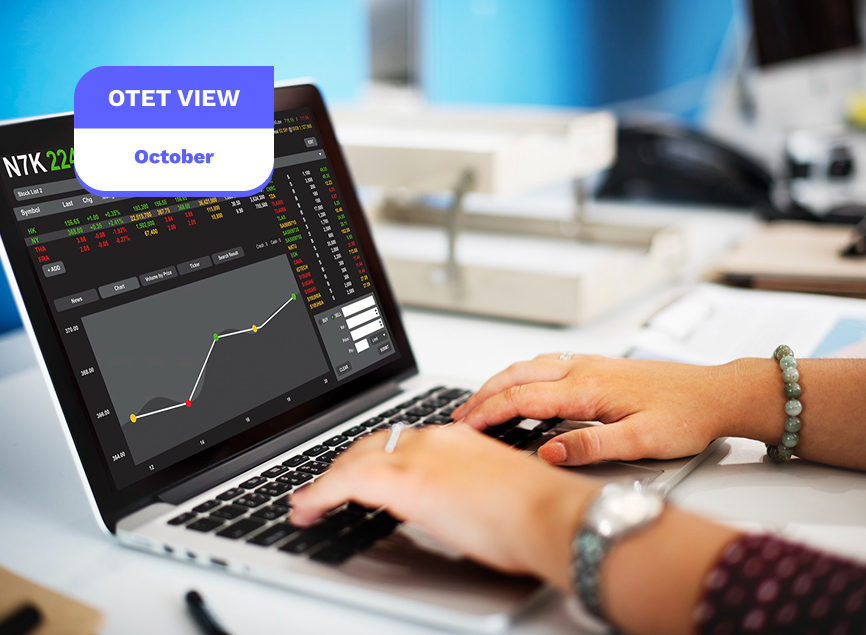
Global Economic Outlook, October 2025
Global growth is heading into October on a shaky footing. Services are holding up reasonably well, but manufacturing remains uneven, and the pace of disinflation is losing steam. Central banks are treading carefully, the Fed is still leaning toward easing, the ECB is staying on pause, the BoE is taking a wait-and-see stance, and the BoJ is inching toward normalization. China’s recovery looks patchy, while across emerging markets, the story is split. India continues to show real resilience, whereas others are only just finding their footing.
USA
U.S. Economic Review – September 2025
The U.S. economy carried solid momentum into September, with services driving growth. The ISM Services PMI (52.0) and S&P Global Services (54.5) pointed to ongoing expansion, while the Composite PMI (54.6) eased slightly but remained resilient. Goods data were softer, as factory orders fell –1.3% MoM, though core durable goods rose +1.0%, suggesting stable underlying demand. The Atlanta Fed revised Q3 GDPNow to 3.9%, and Q2 GDP was also revised higher to 3.8%, underscoring U.S. outperformance.
The labor market continued to cool. Nonfarm payrolls added just +22k jobs, unemployment rose to 4.3%, and broader U6 hit 8.1%. Opening slipped (7.18M), ADP reported +54k gains, and weekly jobless claims ticked higher. Still, productivity growth (+3.3%) and softer unit labor costs (+1.0%) helped ease wage pressures. Businesses remain cautious—slow to hire but equally reluctant to cut—leaving the market finely balanced. A demand pickup could revive hiring, but a negative shock risks triggering a feedback loop of weaker income, softer spending, and reduced employment.
Disinflation made further progress. PPI fell –0.1% MoM (+2.6% YoY), with core at +2.8%. Core PCE slowed to 2.9% YoY, edging closer to the Fed’s target. Yet sticky service costs (ISM Prices 69.2) and elevated consumer inflation expectations (1Y 4.8%, 5Y 3.9%) remain challenges.
Consumers stayed cautious: Michigan sentiment dropped to 55.4, despite retail sales strength. Housing showed mixed trends—starts fell –8.5% MoM, but new home sales surged +20.5%, the strongest since 2020. Mortgage rates eased slightly, aiding refinancing but not broader applications.
The trade deficit widened to –$78.3B, while fiscal balances worsened (–$345B in August). Energy data showed crude builds but strong gasoline demand. The Fed cut rates by 25 bps to 4.25%, beginning its easing cycle. Treasuries rallied, the dollar stayed capped, and equities drew support from resilient services and the Fed’s pivot.
U.S. Economic Outlook – October 2025
October is shaping up to be a pivotal month for the U.S. economy, with inflation and consumer demand firmly in focus. The key drivers will be CPI (Oct 15), PPI (Oct 16), and PCE (Oct 31), alongside retail sales and consumer sentiment. Together, these releases will set the tone for the Fed’s Oct 28 FOMC meeting, while the first estimate of Q3 GDP at month-end will anchor the broader growth picture.
The U.S. still stands out among advanced economies. Strong consumption, services resilience, and productivity gains offset cooling in the labor market and persistent housing headwinds. Disinflation is making progress, but sticky services—particularly shelter and “other services”—and elevated food prices remain the biggest obstacles. Alternative inflation measures suggest underlying pressures near 2.7% YoY, still above target. That makes another October rate cut less likely unless soft goods prices or subdued PPI tilt the balance.
Consumers remain the backbone of growth. August retail sales beat expectations (+0.6% MoM, +5.0% YoY; +0.7% ex-autos), keeping Q3 GDP tracking strong at 3.8% annualized (per Atlanta Fed GDPNow). But sentiment is fragile: the Michigan survey slid to 55.4 in September, with both expectations and current conditions weaker. The divergence—solid spending but fading confidence—underscores the risk that consumption could cool more sharply if income or credit conditions deteriorate in Q4.
Industrial activity remains soft. August industrial production rose only +0.1% MoM (+0.9% YoY), with manufacturing output +0.2%. Capacity utilization stayed at 77.4%, still below long-run averages. Consensus points to just another +0.1% gain in September and utilization drift toward 77.7% by quarter-end. Mining and utilities are offering some lift, but global demand weakness and supply chain fragility keep risks tilted to the downside.
Externally, the trade deficit widened to –$78.3B in July, reflecting stronger imports and a narrower services surplus. That said, Q2 GDP was revised up to 3.8% annualized, and the Q2 current-account deficit narrowed to 3.3% of GDP, showing some balance sheet resilience.
Overall, October will test whether the U.S. can sustain strong consumption while inflation moderates. Growth remains firmer than in Europe or Japan, keeping Treasuries supported, the dollar capped but steady, and equities volatile yet underpinned on dips.
Federal Reserve Policy – October 28 FOMC Meeting
The October FOMC meeting will be the central event of the month, shaping U.S. market direction. Core PCE inflation remains near 3%, still above the Fed’s 2% target, while labor market conditions continue to soften. This mix—sticky inflation but fragile employment—makes it difficult for the Fed to push ahead with its easing bias as aggressively as markets expect. A further complication is the federal government shutdown, which has delayed official data releases, leaving policymakers with a thinner evidence base. That raises the odds the Fed will lean on a cautious script, stressing flexibility and data dependence rather than committing to a clear easing path.
In this environment, the U.S. dollar is likely to finish October with modest strength, supported by safe-haven demand and the perception that U.S. policy remains tighter than peers. Wall Street, by contrast, faces pressure: less data visibility means higher volatility, and a fragile labor market risks amplifying a slowdown through weaker incomes, consumption, and hiring—potentially turning today’s mild cooling into something more damaging.
USD Outlook (DXY)
The dollar is expected to trade range bound by a slight upward bias. The Fed’s easing stance and limited data flow dampen hawkish positioning unless inflation surprises. At the same time, the lack of fresh catalysts rallies. Treasury yields—particularly the 10Y/30Y term premium—will be the swing factor; any compression there would tilt the dollar softer, while sustained long-end pressure supports it.
Wall Street Outlook
Equities are likely to grind sideways with a downside lean. Services strength and easing inflation should cushion multiples, but uncertainty over policy and missing data keep volatility elevated. The bias favors caution: accumulate high-quality, cash-rich mega-caps and services-exposed cyclicals on pullbacks, while hedging with duration if inflation prints soften.
UK Economic Review – September 2025
The UK remains caught in a stagnation–inflation trade-off, with services carrying the economy while manufacturing, construction, and trade weigh on growth. Inflation is easing but remains elevated, consumer sentiment is fragile, and the Bank of England (BoE) is forced to tread carefully.
Growth & Activity
Services continued to prop up momentum, with the Services PMI at 54.2 and the Composite PMI at 53.5, both above expectations. But the divergence across sectors was stark: Construction PMI stayed in contraction at 45.5, and industrial activity weakened, with output down –0.9% MoM and manufacturing –1.3% MoM. GDP for July was flat (0.0% MoM, +1.4% YoY), while the three-month average showed just +0.2%. NIESR’s August estimate added a modest +0.3%, pointing to subdued momentum.
Consumers & Housing
Household demand provided a modest boost. Retail sales rose +0.6% MoM (+1.1% YoY), exceeding forecasts, though consumer confidence slipped further to –19. Housing showed a mixed picture: Halifax HPI increased +0.3% MoM and +2.2% YoY, while average mortgage rates eased slightly to 6.86%. Affordability, however, remains tight.
Inflation & Prices
Headline CPI held at 3.8% YoY, with 3.6%evidence of gradual disinflation. Yet expectations ticked up to 3.6% from 3.2%, suggesting households still anticipate sticky price pressures.
Trade & Fiscal
The trade deficit widened to –£22.24B, underscoring ongoing weakness in external demand and Brexit frictions. Fiscal pressures intensified, with borrowing jumping to £18B in September. Credit conditions improved modestly, with stronger mortgage approvals and lending, though money supply growth stayed uneven.
BoE & Markets
The BoE held rates at 4.0%, but a split emerged as two MPC members voted for cuts. Sticky inflation argues against premature easing, yet softening growth supports a gradual dovish tilt. Sterling held some ground on resilient services and inflation expectations, but downside risks remain, while gilts eased as markets priced a slower policy path.
UK Economic Growth Outlook – October 2025
The UK enters October still leaning heavily on services to sustain growth, while manufacturing and construction remain stuck in weakness. The result is only modest expansion at best, with risks tilted toward stagnation. Disinflation is underway, but progress is slow: headline and core CPI are expected to ease slightly, while services inflation remains stubborn. Wages are cooling, unemployment is nudging higher, and affordability pressures continue to cap household spending. Meanwhile, public borrowing keeps gilt supply under scrutiny. With no Bank of England (BoE) meeting this month, policy remains data-dependent into November, when the MPC will reassess.
PMIs & Growth Trends
The October PMI releases set a weaker tone. Services slipped toward stagnation, while manufacturing PMI held at 46.2, marking a 17th straight month in contraction. September brought the slowest pace of expansion since early 2024, reinforcing signs of lost momentum after the summer rebound. The August monthly GDP print (due Oct 16) is expected at just +0.1% m/m, keeping Q3 in positive territory but underscoring stagnation risks.
Labor Market
October 14 ONS labor release is a key test. Unemployment is expected to stay near 4.3%, though vacancies are set to fall further. Wage growth remains high at 5.6% YoY, but momentum is easing. The mix of softer employment with sticky pay will be central for the BoE’s policy path.
Inflation
The BoE projected headline CPI would edge higher to ~4% in September, driven by food and administered prices, as earlier energy relief fades. Core inflation is estimated at 3.7% and services at 5.8%. While the central bank views the uptick as temporary, risks remain around wages and commodity costs.
Fiscal & Credit Conditions
Public borrowing surged in September, adding to fiscal strain. Credit indicators improved modestly, with lending and mortgage approvals rising, though overall money growth stayed patchy. The Autumn Budget, due in November, looms large, with speculation over tax hikes or spending cuts weighing on sentiment.
Key Data Ahead
- Oct 21: Public Sector Finances
- Oct 22: Full inflation pack (CPI, PPI, RPI, CPIH)
- Oct 24: Retail Sales & GfK Consumer Confidence
- Mid-late Oct: Treasury & OBR forecasts
Pound Outlook
Sterling may find modest upside vs USD if dollar strength eases, but risks remain wide. Against the euro, fiscal stress and weak data keep downside bias in play. Markets will watch inflation and fiscal signals closely, with sentiment fragile ahead of the Autumn Budget.
Eurozone Economic Review – September 2025
The Eurozone remains locked in a low-growth, low-inflation environment, with only modest resilience and wide divergence across member states. September data reinforced the picture of stagnation: growth was barely positive, inflation hovered near target, and business surveys highlighted a fragile backdrop. Markets interpreted the mix as dovish—bond yields stayed supported by subdued pipeline pressures, while the euro traded range-bound.
Growth & Activity
The Composite PMI held at 51.0, just above breakeven, while Services PMI eased to 50.5, pointing to fading momentum. France’s services and composite readings (49.8) slipped just under 50, and Germany’s services dropped back into contraction (49.3), dragging its composite to 50.5. Construction was a persistent drag, with PMI at 46.7. Industrial data showed mixed signals: Germany rebounded (+1.3% MoM, +1.5% YoY), Spain remained strong (+2.5% YoY), but France fell again (–1.1% MoM).
Labor, Consumers & Prices
Unemployment edged down to 6.2%, the lowest in over a decade, underscoring labor market resilience. But retail sales softened (–0.5% MoM, +2.2% YoY), showing consumers remain cautious. Producer prices were nearly flat (+0.4% MoM, +0.2% YoY), reflecting subdued cost pressures. National inflation confirmed the disinflation trend: Germany’s HICP rose +2.1% YoY, France’s slowed to +0.8% YoY, and Spain’s was +2.7% YoY. At the bloc level, CPI held at 2.0% YoY, with Core at 2.3%right around the ECB’s target.
External & Sentiment
Confidence indicators stayed fragile. ZEW expectations improved (Eurozone 26.1, Germany 37.3), but current conditions remained deeply negative (–76.4). The Sentix index fell further to –9.2. Germany’s current account surplus narrowed to €14.8B, reflecting weaker trade dynamics.
Policy & Markets
German Bund yields traded between 2.25–2.77%, while Spanish yields drifted higher amid fiscal concerns. The ECB kept its easing bias intact, supported by subdued inflation and stagnating growth. For markets, this means bond support continues, but the euro stays capped, trading sideways without a clear catalyst.
Eurozone Economic Outlook – October 2025
The Eurozone enters October in a fragile state, with growth momentum weak and inflation hovering near the ECB’s target. Unemployment edged up to 6.3%, while PMI surveys confirmed manufacturing remains stuck below the 50-contraction line, underscoring the drag from industry. Services are only marginally positive, leaving the block perilously close to stagnation.
Key Data & Events
Markets will focus on several critical releases this month. The sentix Investor Confidence survey (Oct 6) offers the first sentiment check, followed by retail sales (Aug) for clues on consumer demand into Q4. Industrial production (Aug) arrives on Oct 15, testing whether July’s rebound will be held. On Oct 17, the full HICP inflation pack (Sep) will be released, with emphasis on services and core inflation trends. The centerpiece is the ECB Governing Council meeting in Florence (Oct 29–30), with the decision and President Lagarde’s press conference likely to set the market tone. Finally, the flash HICP for October (Oct 31) provides the month’s inflation benchmark.
ECB Outlook
The ECB is expected to keep rates unchanged—Deposit Facility at 2.00% and main refi around 2.15%—while maintaining a cautious easing bias. September flash HICP rose to 2.2% YoY (core ~2.3%, services ~3.2%), close to or slightly above target. That removes urgency for further cuts, especially as PMIs hover near stagnation. The baseline expectation is a dovish hold: acknowledging weak demand while stressing patience on inflation.
Lagarde’s recent remarks that inflation risks are “quite contained” and current rates “well placed” align with this view. ECB staff projections put 2025 inflation at ~2.1% and growth near 1.2%, suggesting the bar for further near-term easing is high.
Market Implications
Bund yields are likely to stay steady, the euro to trade range-bound, and periphery spreads to remain sensitive to fiscal commentary. Markets will parse Lagarde’s tone:
- A dovish tilt (emphasis on weak growth) could bull-steepen curves and weigh on EUR.
- A hawkish tilt (focus on sticky services inflation) could support EUR and flatten curves.
Japan Economic Review – September 2025
Japan’s economy showed a fragile but modestly positive picture in September. GDP grew +0.5% QoQ (+2.2% annualized), stronger than expected, supported by household consumption (+0.4%) and external demand (+0.3%). Services activity was steady, with the PMI Services at 53.1 and Composite at 52.0, both in expansion territory. However, sentiment surveys were less upbeat: the Economy Watchers Survey slipped to 46.7, still below neutral.
The industrial side remained weak. Industrial production fell –1.2% MoM in July, with capacity utilization down –1.1%, signaling pressure in manufacturing. Yet investment was firmer—machine tool orders rose +8.1% YoY, and the Reuters Tankan index improved to 13, pointing to improving corporate confidence despite production softness.
The labor market continued to provide support. Wages rose +4.1% YoY, with overtime pay up +3.3%. Credit conditions were stable, with bank lending up +3.6% YoY and money supply growing modestly (M2 +1.3%). These gains underpin household incomes and consumption resilience.
Inflation data showed signs of cooling. Nationwide CPI/Core CPI held at 2.7% YoY, above the BoJ’s 2% target, but Tokyo Core CPI eased to 2.5%. Underlying inflation (ex-food & energy) dropped sharply to 1.0% YoY, the weakest in over a year, suggesting disinflationary risks.
Trade remained a drag. Exports were flat (–0.1% YoY), imports fell –5.2%, and the trade deficit hit –¥242.5B. The current account surplus narrowed to ¥1.88T. Meanwhile, FX reserves climbed to $1.324T. Portfolio flows reflected caution: foreigners bought bonds (+¥1.48T) but sold equities (–¥2.03T).
Policy remained steady. The BoJ left its policy rate at 0.50%. But rising yields show markets testing its resolve: the 30Y JGB yield hit 3.264% (cycle high), the 10Y rose to 1.612%, and the 5Y reached 1.12%, the highest since 2011. Rising term premium reflects investor skepticism about prolonged easy policy.
Markets interpreted this mix as stagflation risks: solid wages and above-target inflation against weak trade and output. The yen gained support from policy-normalization expectations, while equities struggled with higher financing costs.
Japan Outlook – October 2025
October begins with a fragile but shifting landscape. METI surveys point to a rebound in industrial production after August’s drop, while retail sales will test consumption momentum into Q4. Inflation is expected to hold near 2.7% YoY, with the Tokyo CPI (Oct 30) offering the timeliest signal of core trends.
Key data include the BoJ Sakura Report (Oct 6), Balance of Payments (Oct 8), National CPI (Oct 23–24), the critical BoJ policy meeting (Oct 29–30), and Tokyo CPI (Oct 30). The October BoJ meeting is expected to deliver a hold with a hawkish tilt. Any rebound in output or sticky services inflation could push the Bank toward firmer normalization language.
Market takes: Rising JGB yields highlight pressure on the BoJ. A less-dovish message would support the yen, while equities stay sensitive to financing costs and industrial momentum.
China Economic Review – September 2025
China closed Q3 with fragile stabilization, supported by services and trade but weighed down by persistent structural headwinds. The Caixin Services PMI rose to 53.0, marking robust expansion, while the Caixin Manufacturing PMI at 50.5 pointed to only a mild return to growth. Industrial production slowed to +5.2% YoY, missing expectations, while fixed asset investment rose just +0.5% YoY, highlighting sluggish business confidence. Retail sales rose +3.4% YoY, but the property sector remained a major drag, with home prices down –2.5% YoY.
Trade was a mixed story. The official data showed a record trade surplus of $102.3B, driven by +4.4% YoY export growth, though imports grew only +1.3%evidence of weak domestic demand. Alternative August data, however, showed export and import contractions, highlighting volatility in flows. FX reserves climbed to $3.322T, their highest since 2022, reinforcing Beijing’s external policy buffer.
Inflation underscores deflation risks. CPI was flat MoM and –0.4% YoY, while PPI fell –2.9% YoY, reflecting excess capacity and weak pricing power. Credit conditions were mixed: TSF rose ¥2.57T (helped by fiscal bond issuance), but new loans disappointed at ¥590B, underscoring bank caution. Liquidity remained modest with M2 +8.8% YoY and loans +6.8%.
The labor market softened. Unemployment rose to 5.3%, with youth and property-linked services most exposed. Consumer sentiment remained fragile, despite targeted incentives. Policy support persisted through liquidity injections, fiscal spending, and property measures, but long-term risks around housing and corporate leverage linger.
Markets viewed September as one of fragile stabilization: positives included services strength, record surplus, and robust reserves; negatives were deflationary pressures, weak consumption, property drag, and rising unemployment. The yuan held steady under PBoC management, while equities stayed mixed, reflecting optimism in policy but concern over weak fundamentals.
China Outlook – October 2025
China enters October with a fragile recovery narrative. The Golden Week holidays (Oct 1–8) are expected to provide a temporary lift to services—travel, catering, and entertainment. Rail travel hit records on the first day, but disruptions from Typhoon Matmo could limit gains in southern regions. Final tallies will determine the net impact, but the holiday should support Q4 service-sector momentum.
The critical release is Q3 GDP (mid-October), expected around +1.1% q/q, slower than H1, reflecting weak manufacturing and subdued domestic demand. Official PMIs show manufacturing contraction for a 6th consecutive month (NBS 49.8) and non-manufacturing at 50.0, barely above neutral, confirming the sluggish backdrop despite firmer private-sector Caixin readings.
Inflation remains a concern. The September CPI/PPI (Oct 10–12) are likely to show CPI near zero or slightly negative, with PPI still in deflation. Food price volatility and excess industrial capacity continue to weigh on price dynamics.
Trade and credit will also be key. Mid-October trade data should show slowing exports and weak imports. Credit data may reveal a modest post-holiday pickup in loans and TSF, but overall credit appetite remains tepid.
The PBoC outlook is for stability, with the Loan Prime Rate unchanged in October. Further modest easing—through rate or RRR cuts—remains possible in Q4. Beijing has already deployed ~¥500B in policy-based financing tools, but the preference is still for targeted rather than sweeping stimulus, balancing growth support with financial stability and currency management.
Market Takeaways
- Equities: Services-linked stocks may benefit short term, but weak macro data could cap gains.
- Industry: Soft production and deflationary prices point to subdued demand.
- Currency: CNH remains policy-managed; its path depends on Fed divergence and domestic easing.
Share
Hot topics

What Is a Forex Robot and How Does It Work?
If you hang out with traders, in person, online, on Telegram or YouTube, you’ve probably seen someone talking about “Forex bots” or trading robots that can do some of the...
Read more




Submit comment
Your email address will not be published. Required fields are marked *